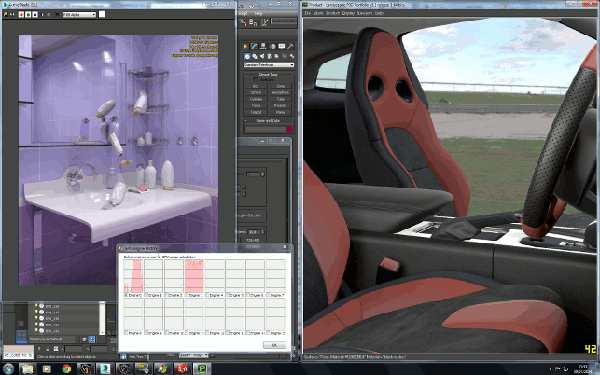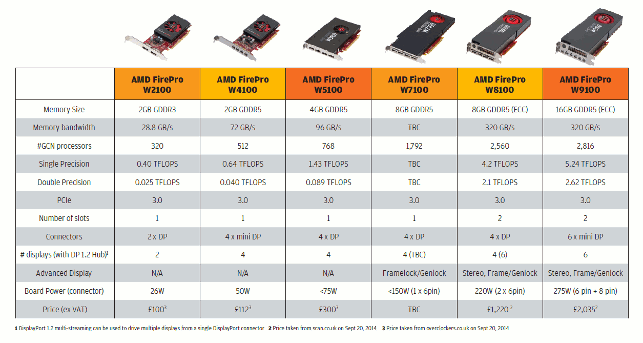It has been close to six months since AMD released the FirePro W9100, but the graphics giant has now completed its next generation professional GPU family with the introduction of four new cards.
The entry-level FirePro W2100 and W4100, plus the mid-range FirePro W5100 and W7100 join the ultra high-end FirePro W9100 and high-end FirePro W8100 that was also launched earlier this year.
The big story is that these cards are brimming with on-board memory; double that of the previous generation. Even the entry-level FirePro W2100 comes with 2GB, which should allow CAD users to load up all but the biggest models into GPU memory.
Then, in the so-called mid-range, the FirePro W7100 takes things up to a whopping 8GB.
While it’s hard to imagine any CAD-centric graphics workflows using anywhere near this amount of GPU memory, 8GB does offer serious potential for GPU compute in simulation and ray trace rendering apps. It also adds in a good level of future proofing.
The entry-level AMD FirePro W2100, a replacement for the ageing FirePro V3900, is being touted to large engineering firms who want to kit out 100s or 1,000s of engineers with professional grade GPUs.
AMD is pitching the card as a cost effective alternative to integrated Intel graphics and at £100 is certainly aggressive on pricing.
With a claimed performance improvement of up to 67% over the FirePro V3900, plus certifications for all the major 3D CAD tools, AMD is presenting it as an entry-level option for users of Inventor, SolidWorks, NX, Creo, Catia and others.
The low profile card has 2GB of onboard memory and support for 4K displays. It has two DisplayPort 1.2 outputs.
AMD calls the 2GB FirePro W4100 a new class of professional GPU – ‘a mid-range CAD card with an entry-level price’ (£112).
Like the FirePro W2100, the W4100 is also a low profile card so it will fit into a small form factor workstation chassis, such as the Dell Precision T1700 or HP Z230. AMD has yet to announce which workstation manufacturers will be taking it up, but it should be an interesting proposition for this sector, which has historically been very limited in its entry-level GPU options.
The W4100 can support up to four 4K displays and features four outputs (mini DisplayPort rather than DisplayPort, presumably so they can all fit onto the low profile card).
The AMD FirePro W5100 is the new midrange workhorse CAD card which boasts 4GB of on board memory, a huge amount for most CAD workflows.
With 1.4TFLOPS of single precision performance it also has potential for GPU compute and should do a fairly decent job of accelerating OpenCL-based ray trace renderers, such a V-RAY RT.
It can support up to four 4K displays with DisplayPort 1.2. AMD calls the FirePro W7100 ‘the ultimate engineering and media and entertainment solution’.
It features a whopping 8GB of on-board memory, double that of the W7000 it replaces, which not only means it can deal with giant graphics datasets, but makes it a serious contender for handling complex, single precision, OpenCL compute workloads.
At time of writing AMD hadn’t nailed down the single precision performance figures of the W7100 but, with its predecessor the W7000 delivering 2.4 TFLOPs, we expect it to be in the order of 3.0 TFLOPs. It can also support up to four 4K displays with DisplayPort 1.2.
It is due to ship a little later than the other cards, which should out very soon, but will still be available this year.
Graphics and compute
Ever since AMD introduced its Graphics Core Next (GCN) architecture it has been trying to get the message out there that AMD FirePro is not just for graphics anymore; it also does compute — and can handle both at the same time on a single GPU.
This is in contrast to Nvidia’s multi GPU approach where one GPU is dedicated for graphics and another (or others) are used for compute.
AMD took a little while to properly implement this into its drivers and the tests we did back in September 2012 showed it still had work to do.
However, the good news is that it now works very well. Set a complex ray trace render going in V-RAY RT, which uses 100% of the GPU’s resources, and your 3D CAD model will still respond instantly when you try to move it about on screen.
This is not only when using a product like SolidWorks, which puts relatively low graphics demands on the GPU, but even in Lumiscaphe P3D, a high-end design viz application which really taxes the GPU. See box out below for more details.
The problem — at least in the product development arena — continues to be a lack of application support. AMD backs the ‘open’ OpenCL standard, which suffers from slow, committee driven development, and it has taken a while for software developers to come on board. AMD says the release of the much more mature OpenCL 2.0 later this year will change this.
In the product development space key applications that currently support OpenCL include V-Ray RT from Chaos Group, Simulia Abaqus, and NX Nastran. However, AMD previewed a new OpenCL 2.0-based ray trace renderer at SIGGRAPH, which could potentially plug into any CAD application.
While GPU compute is theoretically possible on all the new FirePro cards, the W2100 and W4100 lack the raw power to make them serious options.
Single precision applications, such as ray trace rendering, should run pretty well on the AMD FirePro W5100 or W7100, but you’ll probably need the FirePro W8100 or W9100 if you’re really serious about GPU compute — or want to accelerate double precision applications, such as CAE solvers.
Multiple GPUs can also be used in a single machine, which are sometimes branded as AMD FirePro Ultra Workstations.
AMD’s focus on supporting graphics and compute concurrently on a single GPU presents an interesting conundrum for product development professionals.
If it wasn’t hard enough finding the best GPU to match your 3D graphics workflow — today and into the future — choosing a GPU to also match compute workflows that may or may not materialise in the future throws up a whole new challenge.
Our best advice is it to think about the ‘now’ and keep a close eye on how OpenCL touches your application stack later. You can always buy an additional FirePro GPU in the future.
We look forward to testing out the new FirePro GPUs in the coming months.
AMD Mantle: a new graphics API for CAD?
AMD is starting to push Mantle, its brand new graphics API, into the professional space. Mantle is designed to offer an alternative to the established OpenGL and DirectX APIs that are used by virtually all 3D games and CAD applications.
In its basic form a graphics API allows the graphics card driver to communicate with a 3D application.
But why do we need another API? As Mantle is brand new, and optimised for AMD’s GCN architecture, it is designed to be faster and more efficient than OpenGL or DirectX. And, according to an interesting report on Tom’s Hardware , it has the potential to increase performance on systems with slower multi-core host processors.
AMD has initially pushed Mantle in the 3D games sector, a market where it has excellent penetration in gaming PCs and consoles. However, the fact that it is turning its attention to professional applications could be big news.
With DirectX and OpenGL, graphics performance in 3D CAD software is almost always dictated by the speed of the CPU — that’s why 3D performance ramps up with the GHz of the CPU, rather than its cores. Mantle, on the other hand, is designed from the ground up to work with multi-core CPUs, so performance should also rise as you add more cores.
If AMD manages to bring 3D CAD software developers on board with Mantle it could deliver a step change in 3D performance. However, because the API is optimised for AMD’s GCN architecture and will work best on AMD FirePro GPUs, would CAD software developers really back an AMD technology in a market that is still dominated by Nvidia Quadro GPUs?
One could argue that, a) it’s not unheard of for 3D software to support multiple graphics APIs so Mantle could potentially be made available alongside OpenGL and b) if your CAD software is in the cloud, with only pixels being streamed to the desktop, it really doesn’t matter what GPU designers and engineers are using on the desktop.
We look forward to seeing how this develops.
Test drive: Graphics & compute on a single GPU
The AMD FirePro W8100and FirePro W9100 are not only designed for interactive 3D graphics.
Both cards are also optimised for heavy-duty compute tasks. Think OpenCL-accelerated ray trace renderers or simulation solvers.
Thanks to AMD’s Graphics Core Next (GCN) architecture you don’t have to choose between graphics or compute though. Both cards can handle up to eight compute tasks and one graphics task at the same time and, most importantly, switch dynamically between them.

Ray trace render in Vray-RT for 3ds Max (left) and visualise in real time with Lumiscaphe (right)
This means the GPU could be number crunching through a ray trace render but still respond almost instantly when you start to rotate a 3D model.
This is all great in theory so we decided put this to the test using the pre-viz ray trace renderer, V-Ray RT 2.5 for 3ds Max 2014 and SolidWorks 2014 for interactive graphics.
We used Microsoft Process Explorer to track what resources were being used in the FirePro W9100 GPU and FRAPS to record the 3D performance.
Selecting V-RAY RT (OpenCL) as the ActiveShade renderer, 100% of the FirePro W9100’s resources set to work on rendering the scene.
While it crunched its way through the ray trace render we loaded up a large assembly in SolidWorks, turned on RealView and started moving the model around on screen. Impressively, it responded instantly, and could be rotated very smoothly.
With FRAPS we recorded the frame rate, with and without V-Ray RT. Amazingly there was only a small performance drop of around 5% with the ray trace renderer running in the background.
However, as SolidWorks doesn’t really stress the FirePro W9100 too much (Process Explorer only showed 25% GPU resource utilisation) we upped the ante with Lumiscaphe P3D v5.1, a high-end design viz tool that delivers exceptional quality interactive graphics with real-time reflections and transparency.
Compared to SolidWorks it takes real-time visualisation to a whole new level. With a complex automotive styling model GPU resource utilisation went up to 100%, with the FirePro W9100 delivering an impressive 60FPS.
When Vray-RT was turned on it dropped down to 30FPS but most importantly, the model still felt very responsive.
Under the hood the FirePro driver momentarily pauses some of the compute operations and starts them again as soon as the graphics task stops.
Overall, our tests indicate that AMD has done an exceptional job of turning the humble ‘graphics card’ into a true multi purpose processor.
In traditional 3D workflows powerful GPUs like the FirePro W8100 and W9100 often sit idle when you’re not spinning models around on screen. But when you can set them to work on compute intensive tasks and experience no discernible lag when you need a burst of power for 3D graphics, it opens up the GPU to a whole new world of possibilities.
Now AMD just needs the OpenCL applications so it is supported more widely.







